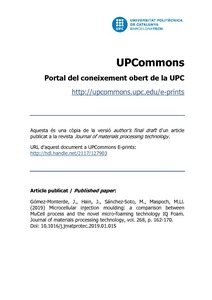Mostra el registre d'ítem simple
Microcellular injection moulding: a comparison between MuCell process and the novel micro-foaming technology IQ Foam
| dc.contributor.author | Gomez-Monterde, J. |
| dc.contributor.author | Hain, J |
| dc.contributor.author | Sánchez Soto, Miguel |
| dc.contributor.author | Maspoch Rulduà, M. Lluïsa |
| dc.contributor.other | Universitat Politècnica de Catalunya. Departament de Ciència dels Materials i Enginyeria Metal·lúrgica |
| dc.date.accessioned | 2019-01-30T13:56:12Z |
| dc.date.available | 2021-01-24T01:42:01Z |
| dc.date.issued | 2019-01-24 |
| dc.identifier.citation | Gomez-Monterde, J. [et al.]. Microcellular injection moulding: a comparison between MuCell process and the novel micro-foaming technology IQ Foam. "Journal of materials processing technology", 2019, vol. 268, p. 162-170. |
| dc.identifier.issn | 0924-0136 |
| dc.identifier.uri | http://hdl.handle.net/2117/127903 |
| dc.description.abstract | The present work aims to compare two different injection moulding foaming technologies, the already known MuCell® process and the new emerged technology IQ Foam®, as well as the cell structure and mechanical behavior of the obtained components. Glass fiber reinforced-polypropylene (>PP GF<) was employed to produce rectangular plates at solid and foamed conditions by using MuCell® and IQ Foam® processes combined with the complementary Core Back expansion molding technology, and the material structure as well as the tensile, flexural and impact properties were studied. A solid skin-foamed core structure was observed in the samples foamed by both techniques. The mechanical properties decreased gradually with the apparent density of the microcellular plates. By increasing the thickness of the part because of the expansion of the cavity with the Core Back technology, the apparent density decreased but the flexural stiffness was greatly enhanced. Foamed samples obtained by IQ Foam® technology exhibited thicker solid surface layers and lower cell density than that of the MuCell® ones, but consequently higher resistant area, and thus, slightly higher mechanical properties. The new IQ Foam® technology is able to produce foamed parts with properties comparable to that of the MuCell® process, offering additional benefits such as cost-effectiveness, easy to use and machine-independence |
| dc.format.extent | 9 p. |
| dc.language.iso | eng |
| dc.rights | Attribution-NonCommercial-NoDerivs 3.0 Spain |
| dc.rights.uri | http://creativecommons.org/licenses/by-nc-nd/3.0/es/ |
| dc.subject | Àrees temàtiques de la UPC::Enginyeria dels materials::Materials plàstics i polímers |
| dc.subject.lcsh | Injection blow molding |
| dc.subject.lcsh | Injection molding of plastics |
| dc.subject.lcsh | Plastic foams |
| dc.subject.lcsh | Polypropylene fibers |
| dc.subject.other | Microcellular injection molding |
| dc.subject.other | Plastic foams |
| dc.subject.other | Polypropylene-glass fibers |
| dc.title | Microcellular injection moulding: a comparison between MuCell process and the novel micro-foaming technology IQ Foam |
| dc.type | Article |
| dc.subject.lemac | Emmotllament (Tecnologia química) |
| dc.subject.lemac | Escumes plàstiques |
| dc.subject.lemac | Polipropilè |
| dc.contributor.group | Universitat Politècnica de Catalunya. e-PLASCOM - Plàstics i Compòsits Ecològics |
| dc.identifier.doi | 10.1016/j.jmatprotec.2019.01.015 |
| dc.relation.publisherversion | https://www.sciencedirect.com/science/article/pii/S0924013619300214 |
| dc.rights.access | Open Access |
| local.identifier.drac | 23646518 |
| dc.description.version | Postprint (author's final draft) |
| local.citation.author | Gomez-Monterde, J.; Hain, J.; Sanchez-Soto, M.; Maspoch, M. |
| local.citation.publicationName | Journal of materials processing technology |
| local.citation.volume | 268 |
| local.citation.startingPage | 162 |
| local.citation.endingPage | 170 |
Fitxers d'aquest items
Aquest ítem apareix a les col·leccions següents
-
Articles de revista [960]
-
Articles de revista [46]


